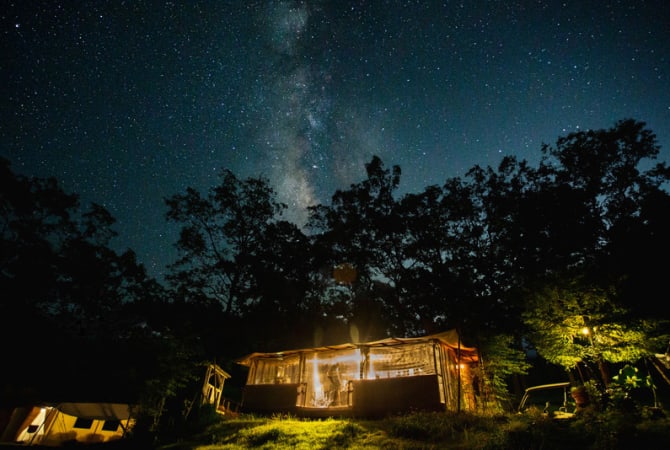A Beginner's Guide to Onsen
Apart from sushi, ramen, anime and J-pop, Japan is also known for having some of the best onsens (hot springs) in the world. Going to an onsen is not only the ultimate bathing experience, but it’s also perfect for weary travellers who need to ease muscle tension and physical stress from jumping from one itinerary stop to another. Other health benefits also include promoting blood circulation, soothing one’s mind, and encouraging better sleep.

But unlike your typical spa trip, a Japanese onsen has rules and an etiquette that must be kept in mind. Planning to go to one on your first time in Japan? Make sure you read these first.
1. Most onsens still require full nudity and no tattoos so do your research before visiting
Majority of the onsens in Japan prohibit tattooed guests from entering and require full nudity once you enter the bathing room. And while in recent years some establishments started offering more options for modest travellers or are more relaxed with tattooed guests, it’s still best to inquire to your onsen of choice before visiting to avoid any issues.
2. Remember the signs in the changing rooms
Asians are pretty used to leaving their shoes by the door when entering their own or someone else’s home. The same goes for onsens. Slippers are provided and you can use them on the tatami floors. These are usually found at the entrance of the changing rooms where you’ll also leave your clothes and other belongings.

Women’s changing rooms are usually designated using a red curtain or signage and the ones for men are blue. However, it’s still safer to refer to the Japanese kanji labels 女 (onna) for women and 男 (otoko) for men.
So, how exactly are you supposed to walk from the changing room to the bathing area? Small washcloths are provided to cover your intimates and are the only things you can bring to the onsen room.
3. Shower first, dip later
Another onsen etiquette to take note of is entering the onsen water properly. Showers or cleansing areas are found in between the changing area and the actual onsen. Sit on small stools and wash with the shower or small bucket provided and make sure there’s no trace of soap left.

4. Don’t let your washcloth touch the onsen water
Once you’re done, pat yourself dry but don’t leave your towel by the showers. You shouldn’t let it touch the onsen water either. Leave the towel off to the side of the bath or do as the onsen experts do and balance the towel on your head as you take a soak.
5. Enjoy the experience and try scenic outdoor onsens if you can

If you want to take your onsen experience to the next level, consider outdoor onsens that provide amazing scenery like the Kurokawa Onsen town in Kumamoto Prefecture. This onsen town went to lengths to ensure that the place retains its traditional atmosphere, away from big commercial establishments, so that visitors can make the most out of their getaway minus any distractions.

©乳頭温泉組合
There’s also Nyuto Onsenkyo located at the Towada-Hachimantai National Park in Akita Prefecture. Seven onsen resorts are scattered around the area, and this spot traces back its history to over 350 years. Each onsen boasts a different type of charm thanks to its surrounding naturescapes, all providing a different view of foliage depending on the season.
An ideal place to visit at Nyuto Onsenkyo is Kuroyu Onsen where the foliage paint the surrounding landscape of the hot spring in various colours depending on the season (except for winter when the facility is closed).

Ibusuki City in Kagoshima Prefecture is also known for its amazing hot springs, as well as natural steam sand baths. Natural steam sand baths have guests buried in the sand along the beach with only the head exposed, allowing the sand’s natural thermal heat to ease the body from any pains or aches. Visitors are then recommended to head over to the nearby onsens to rinse and soak in hot spring water to round up the experience.

‘Tamatebako’ Outdoor Hot Springs in this region provide a great way to cap off the experience with a stellar view of Mount Kaimon and Yakushima Island, a UNESCO World Heritage Site. This onsen also has a Western-style bath for those who prefer a less traditional aesthetic. From there, guests can view Mount Takeyama’s peak, also known as Snoopy Mountain because of its shape.

If you want something a little more unique, head to Iya Onsen, located in the serene paradise-like Iya Valley, which you’ll need a cable ride to reach. Aside from the scenic mountain view surrounding the onsen, this facility also prides itself in having gentle alkaline water that’s good for nerve pain, external wounds, rheumatism, and various women’s health issues.

Matsudai Shibatoge Onsen Unkai in Tokamachi City, Niigata Prefecture is another must-visit outdoor onsen destination for its ‘above the clouds’ panoramic view of the surrounding landscape. This location is unparalleled for its otherworldly feel.
Visiting an onsen is for relieving both physical and mental stress so make sure to make the most out of the experience.
|
Kurokawa Onsen Ryokan Association https://www.kurokawaonsen.or.jp/eng_new/ Nyuto Onsenkyo http://ryokan.glocal-promotion.com/ Discover Kagoshima Official Tour Guide https://www.kagoshima-kankou.com/for/areaguide/ibusuki Iya Onsen Shibatouge Onsen |



























































